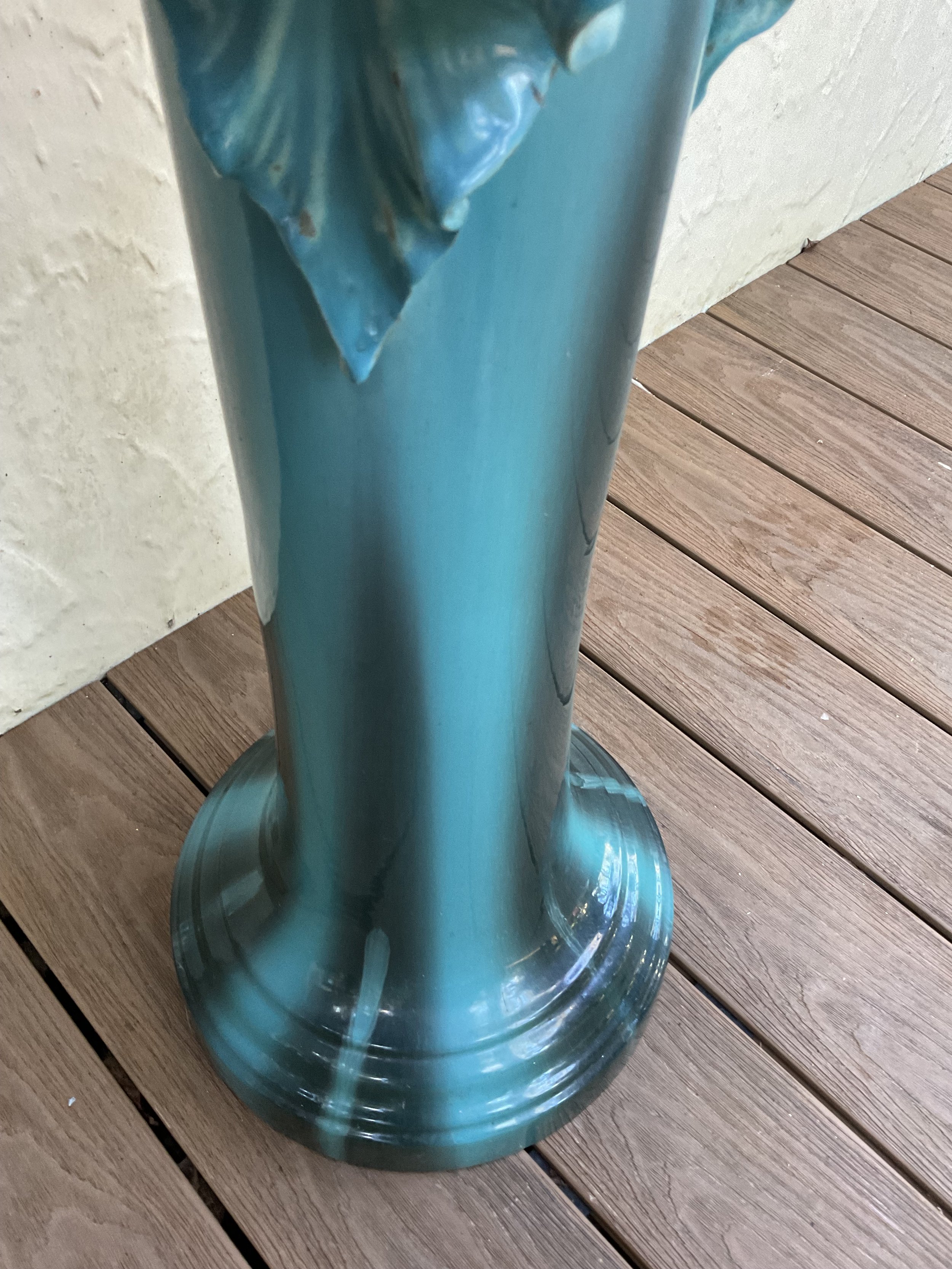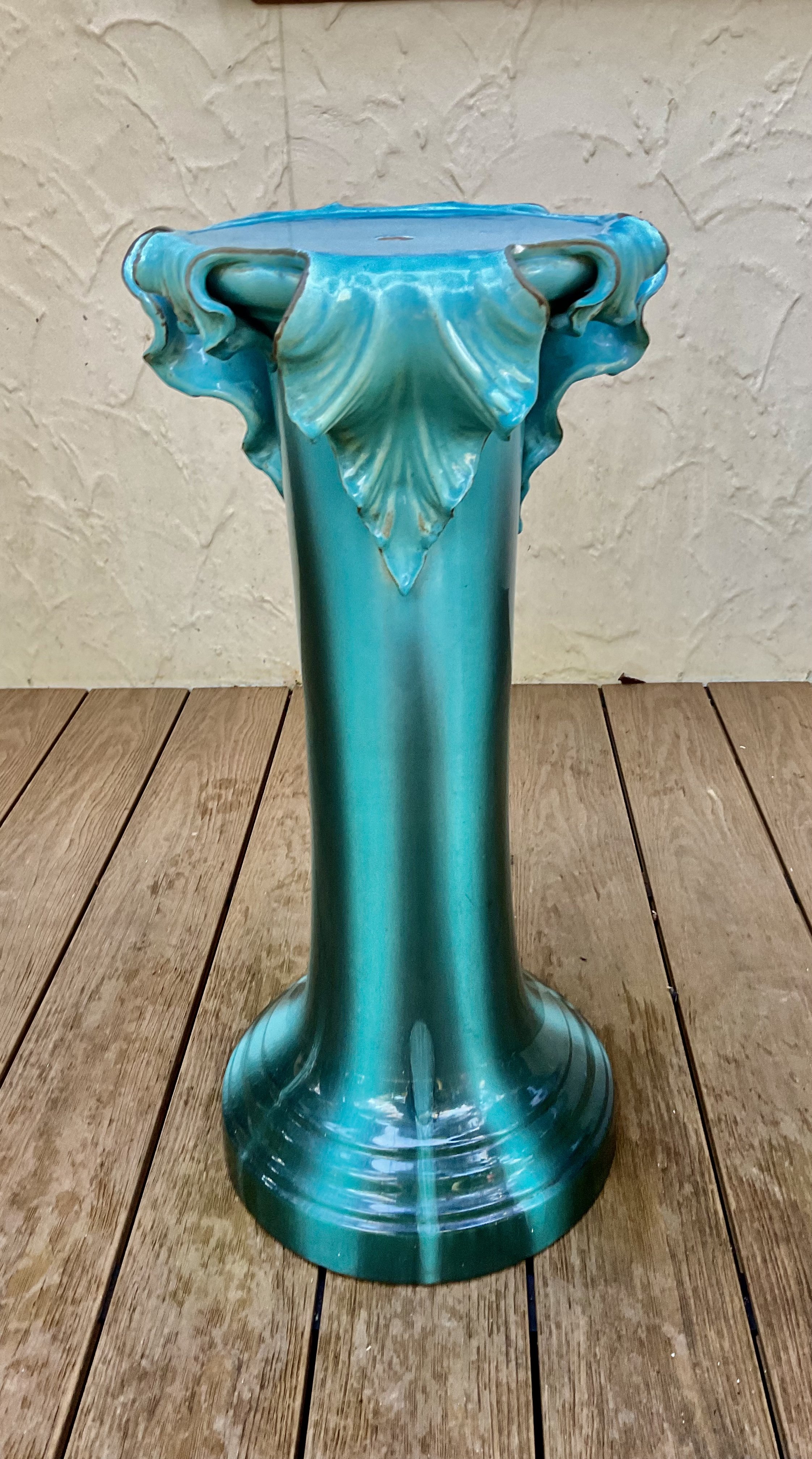 Image 1 of 14
Image 1 of 14

 Image 2 of 14
Image 2 of 14

 Image 3 of 14
Image 3 of 14

 Image 4 of 14
Image 4 of 14

 Image 5 of 14
Image 5 of 14

 Image 6 of 14
Image 6 of 14

 Image 7 of 14
Image 7 of 14

 Image 8 of 14
Image 8 of 14

 Image 9 of 14
Image 9 of 14

 Image 10 of 14
Image 10 of 14

 Image 11 of 14
Image 11 of 14

 Image 12 of 14
Image 12 of 14

 Image 13 of 14
Image 13 of 14

 Image 14 of 14
Image 14 of 14















Amazing French Majolica Art Nouveau Jardiniere
This unusual French majolica jardiniere, circa 1890, is on its original stand. It is a marvellous shade of blue. It carries the maker's mark of Massier. The Massier family were a French dynasty of potters dating back to before the French Revolution. They played a key role in the revival of pottery in Vallauris, France. Clement Massier is regarded as the founder , in the early 20th century, of the modern ceramics industry in Vallauris.
I imagine this beautiful majolica jardiniere may originally have found its way into an orangerie. An orangerie was a grand stately building used to grow oranges and other fruit trees. The orangerie protected the trees during the harsh winter time. Brick pillars sheltered the exotic fruit trees and large expanses of glass ensured the sun’s warmth cultivated the plants. Due to the high cost of glass required to make them, they were considered a status symbol.
Another interesting feature of this gorgeous jardiniere is the historical repair to the bowl, (see photos). At some stage this bowl was broken and repaired long, long ago, definitely not in our time. Hundreds of years ago before the availability of adhesives, pottery was repaired with metal staples or rivets on particularly valuable pieces, holding together the broken ceramic segments. For every metal staple, repairers had to hand drill two tiny holes through clay, ceramic or glass and then carefully hammer the staples in. Today, old ceramic repair is something of a lost art.“Perfect is boring; repair is better. It can even be inspirational.” Andrew Baseman (New York Designer).
The jardiniere and stand is 105 cms in height. The stand itself is 66 cms in height and 31 cms across at its base. The bowl is 31 cms across.
This unusual French majolica jardiniere, circa 1890, is on its original stand. It is a marvellous shade of blue. It carries the maker's mark of Massier. The Massier family were a French dynasty of potters dating back to before the French Revolution. They played a key role in the revival of pottery in Vallauris, France. Clement Massier is regarded as the founder , in the early 20th century, of the modern ceramics industry in Vallauris.
I imagine this beautiful majolica jardiniere may originally have found its way into an orangerie. An orangerie was a grand stately building used to grow oranges and other fruit trees. The orangerie protected the trees during the harsh winter time. Brick pillars sheltered the exotic fruit trees and large expanses of glass ensured the sun’s warmth cultivated the plants. Due to the high cost of glass required to make them, they were considered a status symbol.
Another interesting feature of this gorgeous jardiniere is the historical repair to the bowl, (see photos). At some stage this bowl was broken and repaired long, long ago, definitely not in our time. Hundreds of years ago before the availability of adhesives, pottery was repaired with metal staples or rivets on particularly valuable pieces, holding together the broken ceramic segments. For every metal staple, repairers had to hand drill two tiny holes through clay, ceramic or glass and then carefully hammer the staples in. Today, old ceramic repair is something of a lost art.“Perfect is boring; repair is better. It can even be inspirational.” Andrew Baseman (New York Designer).
The jardiniere and stand is 105 cms in height. The stand itself is 66 cms in height and 31 cms across at its base. The bowl is 31 cms across.
This unusual French majolica jardiniere, circa 1890, is on its original stand. It is a marvellous shade of blue. It carries the maker's mark of Massier. The Massier family were a French dynasty of potters dating back to before the French Revolution. They played a key role in the revival of pottery in Vallauris, France. Clement Massier is regarded as the founder , in the early 20th century, of the modern ceramics industry in Vallauris.
I imagine this beautiful majolica jardiniere may originally have found its way into an orangerie. An orangerie was a grand stately building used to grow oranges and other fruit trees. The orangerie protected the trees during the harsh winter time. Brick pillars sheltered the exotic fruit trees and large expanses of glass ensured the sun’s warmth cultivated the plants. Due to the high cost of glass required to make them, they were considered a status symbol.
Another interesting feature of this gorgeous jardiniere is the historical repair to the bowl, (see photos). At some stage this bowl was broken and repaired long, long ago, definitely not in our time. Hundreds of years ago before the availability of adhesives, pottery was repaired with metal staples or rivets on particularly valuable pieces, holding together the broken ceramic segments. For every metal staple, repairers had to hand drill two tiny holes through clay, ceramic or glass and then carefully hammer the staples in. Today, old ceramic repair is something of a lost art.“Perfect is boring; repair is better. It can even be inspirational.” Andrew Baseman (New York Designer).
The jardiniere and stand is 105 cms in height. The stand itself is 66 cms in height and 31 cms across at its base. The bowl is 31 cms across.
Not suitable for delivery via Australia Post. Collection by appointment. Please make contact if you would like to arrange another type of delivery. Free delivery to some Melbourne metropolitan areas can be arranged.



























